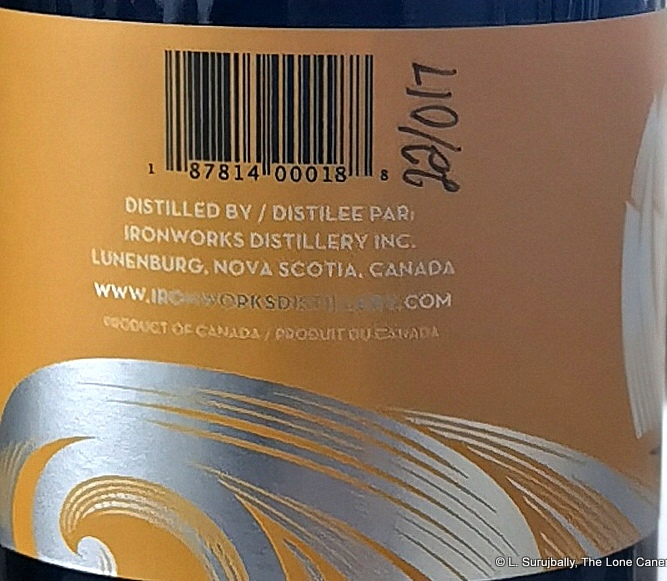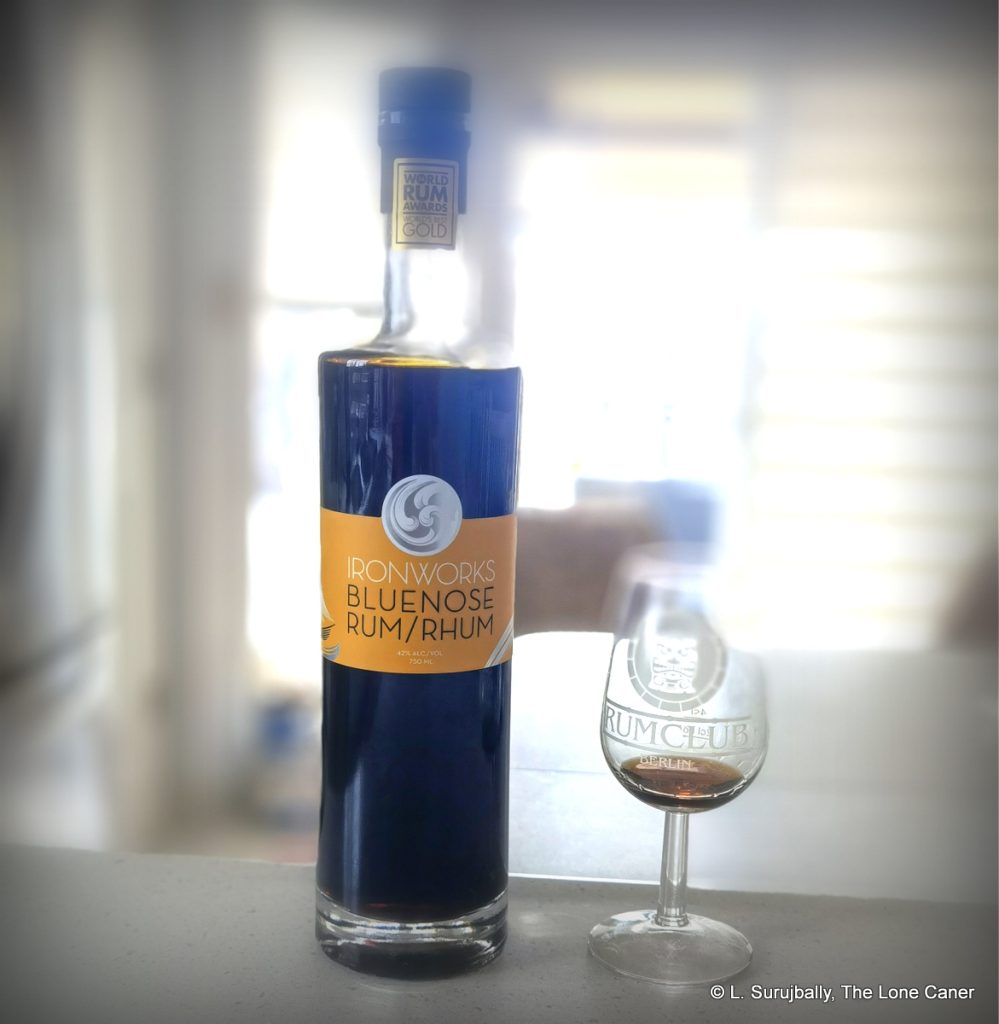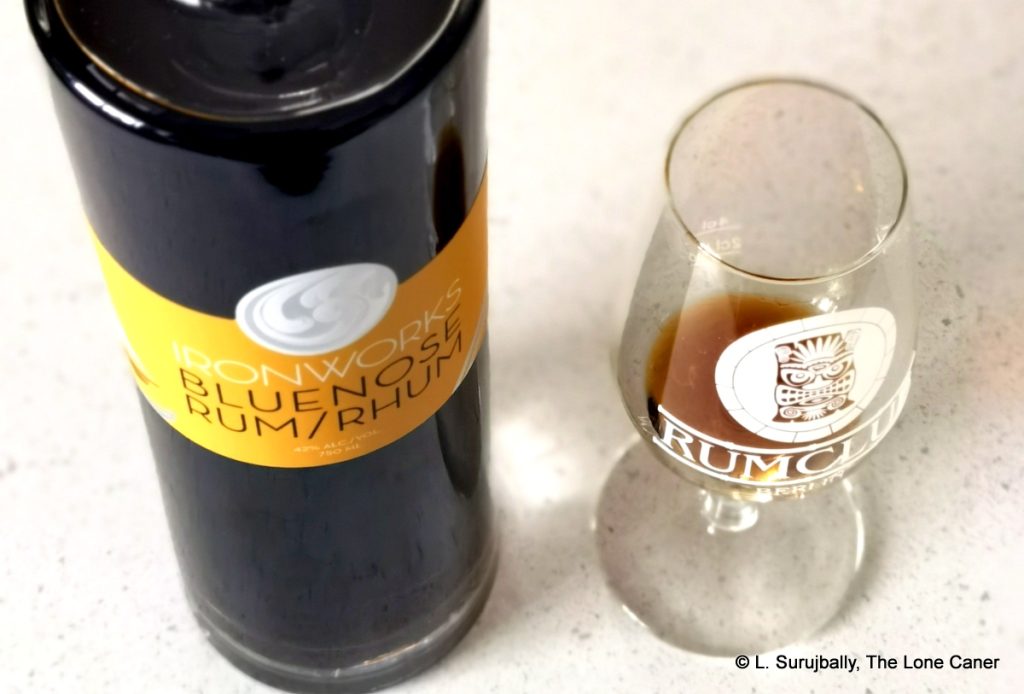The first thing one notices about the rum, even before it’s poured, is the colour – dark, almost black, with reddish tints, and completely not natural. This creates both expectations and dread in the reviewer because firstly, there’s the whole question of additives, and secondly, it suggests the channelling of the Navy Rum vibe of yore, complete with cutlasses, yo ho hos and some sort of faux-Demerara vibe to deceive the unwary. This does not usually end well.
It’s a relief then, that neither of these is obviously or obnoxiously the case, and in fact, the rum presents rather well at first blush, even with a rather lacklustre 42% strength. The nose has a lot of interesting (if restrained) things going on there: tannins, well polished leather and cinnamon to start off with, quite easy to smell, nothing harsh or bloviating, no straining to make a point. There some dark elderberry and cranberry notes, vaguely sour, caramel, a touch of molasses and behind it all, the tang of mauby (a bark made into Caribbean soft drinks by locals) – not at all the “traditional” rum flavours one might be expecting and a far cry from the confected, dosed-to-the-gills Bumbu-esque profile one might think is coming.
 On the palate it comes off as a bit sweet and briny at the same time, the mauby taking on some more heft, accompanied by cinnamon, molasses and a peculiar sort of scent that reminds me of a sunlit damp forest glade, rank with decomposing leaves and mossy logs and the memory of a rain just ceased. There is a hint of some fruits – prunes, elderberries again, a vague cough syrup and grenadine dropped here and there. It’s not bad, all in all, and the finish, while short, at least doesn’t drop the ball, and glides to an easy conclusion with caramel, some sweet prunes, and that slight mauby thing coming onstage for a last bow.
On the palate it comes off as a bit sweet and briny at the same time, the mauby taking on some more heft, accompanied by cinnamon, molasses and a peculiar sort of scent that reminds me of a sunlit damp forest glade, rank with decomposing leaves and mossy logs and the memory of a rain just ceased. There is a hint of some fruits – prunes, elderberries again, a vague cough syrup and grenadine dropped here and there. It’s not bad, all in all, and the finish, while short, at least doesn’t drop the ball, and glides to an easy conclusion with caramel, some sweet prunes, and that slight mauby thing coming onstage for a last bow.
Compared to some of their other efforts, this is a pretty solid rum from the Ironworks Distillery in Nova Scotia (in eastern Canada), though frankly, it would have made more of an impact with several more proof points – 42% really remains too weak. Still, while there are others in the lineup I have not yet tried (including some I don’t want to), as a first introduction to the distillery, I could have picked worse based on label spec. But what are the specs, exactly? There is maddeningly little on the company website.
Here’s what we know: it derives from Guatemalan molasses imported into eastern Canada (which makes it likely to be Crosby’s – they import exclusively from there and are located in the maritimes), fermented on site over a period of weeks (exact time unspecified), and run through an unidentified still which is either a hybrid or a column still made by Muller from Germany. A further unspecified period of ageing takes place in ex-bourbon barrels, and again, while some of their barrels are placed on board the Black Beauty floating boat warehouse in the harbour, we are not told whether any of the components of this rum were from there. Lastly, at no point is the age of the rum mentioned, yet this is a company which proudly touts the age of the “Ten,” their oldest rum.
If you detect the bite of irritated impatience here, you’re right. This is getting to be a thing with Canadian rums and the companies that make then, and it’s annoying as hell. In this day and age, I should not have to make comments about disclosure (i.e., the lack thereof), or email the company or ask for further details. It should be right there on the label or at least in their website — which takes such pains to say who they are and with what pride they what they do. Ironworks has been around for more than a decade, and has steadily amassed a nice stable of regionally appreciated spirits. It’s time to stop with this coy, wink-wink amateur-hour stuff and step up to the big boys table – and part of that is disclosure, not prideful marketing about being the Small Distillery That Could with a scrappy origin story.
I like the rum itself, and am relieved that the inclusion of caramel colouring into the mix to make it darker was not compensation for weaknesses in other areas: and the truth must be told, it’s a more complex and interesting rum than I was expecting — a rum I don’t mind drinking, or mixing. But just as I give it the respect it has earned, I demand that we as consumers are treated with a little more respect in our turn, and provided with the details that would tell us what it is that we just paid forty bucks for.
(#986)(79/100) ⭐⭐⭐
Other notes
- Five minute video recap can be found here.
- The “Bluenose” is a famous Canadian schooner built in 1921 which won many competitions in the 1920s and was exhibited at the Chicago World’s Fair in 1933. Its metal parts were made on the premises of the iron works which the company took over in 2009.
- I have seen an occasional unconfirmed comment that the rum is spiced, but in the absence of more formal evidence, I chose to doubt it. The offbeat taste of the rum is, to more a function of its source material, long fermentation, and maybe even the barrels they use.
- Because of the gradual reduction of North American rum reviewers and the fact that Ironworks does not export much (if at all) other reviews are scant. However, I point you to Rum Revelations’ notes on Canadian rums from late 2022, including their indifference to other Ironworks products. A reddit reviewer gave the Bluenose 83 points in 2013, and stated its age as about one year. RumRatings was more scattershot, and few conclusions can be drawn from their commentariat – about a third of the votes rated it 7/10. Rum-X, as of this writing, does not have an entry for it.
Historical background
Ironworks is a distillery in the Maritime (Canadian) province of Nova Scotia, founded by Pierre Guevremont and Lynne MacKay in 2009, and inspired a year earlier by a random reading of a magazine article on the growth of the spirits industry (I find this odd because it is much more usual for people to start a distillery based on a connection to some spirit or other, or out of real love for a single product line). Quite aside from distillation of quality spirits, they wanted to get deep into the technical aspects of fermentation, distillations, ageing and infusing, all via experimentation and personal experience; as well, they hope to use local ingredients as far as possible, and provide employment for the local economy.
They acquired premises in the small town of Lunenburg, in what was once a marine blacksmith’s workshop that serviced the shipbuilders who operated along the South Shore; and happily also provided the title of the fledgling distillery when the time came to name it. The couple bought a 30,000-litre fermentation tank and a Muller still from Germany (type is not mentioned but I think it’s a hybrid from the few photos I’ve seen), and nowadays source apples, pears, molasses and ferment them all year for a wide ranging spirits portfolio of rum, vodka, brandy, gin and whisky. Barrels are sourced from all over – with an emphasis on ex-bourbon for rum – and the warehousing has expanded beyond the small storage area to a boat, offices and more.
The company met with enough success that after little more than five years, it already had won some twenty awards for its products, and it became one of the few of Nova Scotia’s growing craft distillers with a reputation that expanded outside its home province. Their spirits became popular enough that in early 2016 they partnered up with Halifax’s airport to open a liquor store on the premises to allow passengers to buy alcohol when travelling – and limited it to locally made products only. In 2018 they sent a few barrels around the world in a sailing ship, which some herald as a stunt, but which Ms. McKay defended as an experiment to see if the old tale of spirits ageing better at sea was true or not – the barrels were subsequently blended into the “Around The World Rum”, and rapidly sold out. One could argue as to whether it was marketing or not, but the key takeaway was the willingness of the owners to think a bit outside to box and come up with some ingenious marketing ideas, as well as – one would hope – a more interesting and better rum.
Currently the company makes several different rums, the best known of which are the Amber, the Rum Boat Rum, the “Ten”, the Bluenose and the “Around the World Rum”, the last of which was the special edition referred to above. They also make a rum cream and an experimental rum blended with maple syrup and then aged some more which they call maple rum and which I term an arrangé or infused spirit.
To some extent the rise of the European – and, of late, American – independent bottlers, as well as the obdurate and overly complex regulatory Canadian landscape, has limited the company’s ability to expand as rapidly as they might wish. The lack of concentration on one spirit type is also an issue I’ve commented on before, and does not allow for world class expertise to develop as rapidly as it would for a more laser-focused company. But one must consider the commercial realities of small companies which have to make payroll and generate cash flow, and so, for now, we must accept that Ironworks is a distillery that makes some intriguing rums, and is gradually increasing its footprint and awareness around the country.

